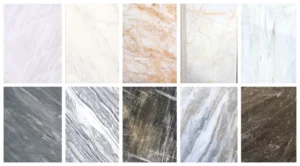Crystal marble, with its dazzling appearance and durability, has become a preferred choice for exterior applications such as facades, walls, stairs, and even floors. As a metamorphic stone, crystal marble combines the elegance of traditional marble with an enhanced tolerance for outdoor conditions. Its bright colors, intricate patterns, and weather-resistant properties make it an appealing option for architects and builders. However, proper installation and maintenance are critical to ensure longevity and functionality. This article provides key tips on selecting, installing, and caring for crystal marble in outdoor spaces.
Before diving into practical tips, it’s essential to understand the characteristics of crystal marble. Like other marbles, crystal marble is formed through the metamorphism of limestone. Over time, pressure and heat transform the stone into a more compact and crystalline structure. This process gives crystal marble its signature smooth surface and reflective qualities.
The key difference between traditional marble and crystal marble lies in their resilience. Crystal marble is better suited to withstand environmental factors such as sunlight, acid rain, and varying temperatures. Its tolerance to harsh outdoor conditions makes it a favorable material for exterior use, but it’s still necessary to follow best practices for installation and care.
Selecting the appropriate type of crystal marble for your outdoor project is critical. While the stone is beautiful and versatile, not all varieties are equally suited for exterior conditions. When making your choice, consider factors like erosion resistance, bending resistance, and water absorption.
Here are some of the most popular and durable types of crystal marble for outdoor use:
The appearance of the stone is often a driving factor in selection, but for outdoor applications, it’s essential to balance aesthetics with functionality. For instance, a stone with many streaks or low epoxy content may not hold up well in cold weather and could crack. When purchasing crystal marble for outdoor use, it’s advisable to choose high-quality, streak-free stones to ensure long-term durability.
Proper installation is the key to maximizing the longevity and performance of crystal marble in outdoor environments. There are two main methods for installing crystal marble on exterior surfaces: using mortar or using the “dry facade” technique.
Proper installation ensures that the stone remains securely in place and can withstand environmental stresses without degradation.
Though crystal marble is widely appreciated for its aesthetic appeal, not all varieties are suitable for outdoor flooring. Due to their susceptibility to weather-related wear, some types of crystal marble may not be the best choice for high-traffic areas exposed to the elements.
To maintain the beauty and functionality of crystal marble floors, it’s important to apply a protective sealant. This will help prevent water absorption and staining, especially in areas where the stone is exposed to rain, snow, or heavy foot traffic.
Crystal marble’s smooth surface and elegant appearance make it a popular choice for outdoor stairs. However, safety must be a top consideration when using this material on stairways, particularly in regions that experience rain or snow. The polished surface of crystal marble can become slippery when wet, increasing the risk of accidents.
Here are some tips to enhance the safety of crystal marble stairs:

Once installed, proper maintenance is crucial to preserving the appearance and structural integrity of crystal marble in outdoor spaces. Regular cleaning and sealing can help protect the stone from the damaging effects of moisture, pollution, and UV rays.
Crystal marble is a versatile and stunning material that can elevate the aesthetic appeal of any outdoor space. By selecting the right type of marble, using proper installation methods, and taking steps to ensure safety and durability, you can enjoy the beauty and benefits of this material for years to come. Whether you’re using it on facades, walls, floors, or stairs, crystal marble offers a timeless, luxurious touch to exterior design.